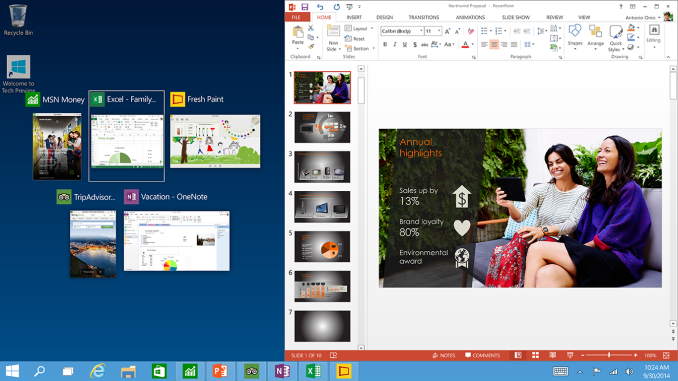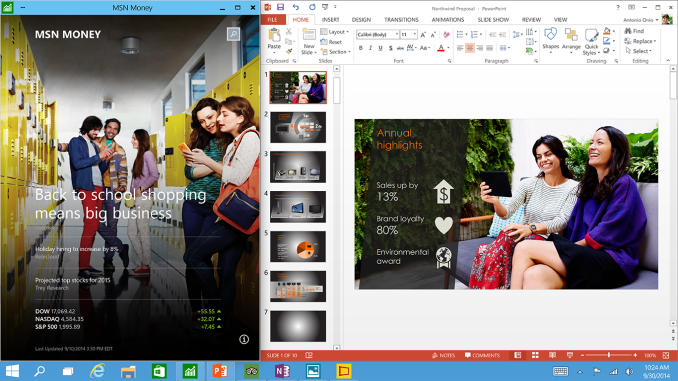Windows 10 Technical Preview First Impressions: The Return Of The Desktop
by Brett Howse on November 13, 2014 8:00 AM EST- Posted in
- Software
- Microsoft
- Windows 10
Closing Thoughts
If Windows 8 was “Touch First” then clearly Windows 10 is not. The current technical preview is very much geared towards the traditional mouse and keyboard user. This will change of course over the next several months, as the touch features get integrated back into Windows 10. As a user of all types of Windows devices, I welcome this change. It allows me to be more productive on my desktop, but still use the touch based Start Screen on a tablet or convertible notebook. Some good things have been done here to hopefully embrace the current user base, as well as new device types.
There are a number of features aimed squarely at businesses. If Microsoft wants to avoid another Windows XP with Windows 7 – where businesses do not migrate until they absolutely have to – then these features are certainly a carrot that may entice them to at least try it out. The Start Menu and other desktop additions will be great for the business users, and I think the IT crowd will be happy with a lot of the new additions around device management, identity management, and information management.
This is a technical preview of course, but still I would be remiss to not mention that it is not without its bugs. I have had a lot of issues with Windows Store apps, with many of them crashing especially when they are not the active window. Possibly there are some changes to the underlying WinRT framework for apps in standby but until we hear more about the framework changes then these problems will likely continue. More of this information should come out around the time of the next BUILD conference, scheduled for April 29th to May 1st 2015. Other issues with WinRT apps currently is that even though they can be used in a window, the absolute height of the window is limited. When Windows 8 was launched, WinRT apps were expecting to be either full screen, or snapped to the side. As such, the apps in a window must maintain a minimum height. Hopefully this can get sorted out in the future.
At first glance, Windows 10 looks like Windows 8 with a Start Menu. It is clearly a lot more than that, but even so, as someone very smart told me, that’s not a bad thing. Windows 8 had a lot going for it, but design decisions were made early on, and with a “my way or no way” attitude that it was difficult to use. It seems that Windows 10 really addresses a lot of this, while at the same time keeping and expanding on a lot of the great features that were in Windows 8 and likely overlooked due to a lot of animosity towards it.
The Windows Store is going to be a big part of this, and if the rumors of desktop apps being integrated into the store is true, then the OOBE for Windows 10 will be amazing. All of your settings and apps will now follow you from device to device, with a single log in. A lot of that is already there with Windows 8, but 10 should finish off the last remaining pieces if this is true. It makes a lot of sense, so unless the licensing terms are awful, this could be a fantastic addition to the store.
The Universal App model is also a big piece of the puzzle, but here there is more work to do. WinRT has a lot of advantages, but the framework needs to be updated at a rapid pace in order to draw developers in. It is somewhat seductive to be able to target desktops, laptops, tablets, phones, and the TV with Xbox One with a single application (with multiple interfaces of course) but until the framework is made powerful enough for more apps than just simple web front ends, it may be difficult to realize this idea. Once again, more info should be available at BUILD in regards to this.
I’ve also had some bugginess with the WinRT apps on Windows 8, which I hope will be fixed with Windows 10. At this point though, the WinRT apps are even buggier so likely there will be more pain before this is all corrected.
Although we have only seen the Technical Preview and a single update to it so far, you can see the potential for Windows 10 and what it will be able to accomplish. It is an ambitious goal to provide a single platform across such a swath of different devices, and one that was held back by the user interface before. With Continuum, it appears that it may be the best of both worlds. Even more exciting is how much more upfront and open Microsoft has been on this entire process, with not just the technical preview but also soliciting and requesting user feedback on the changes. One of the biggest change requests was a simple animation on the Start Menu, and that has already been implemented, so this really is a different world than when Windows 8 was given a sneak peek.
Due to the timing of the latest release that just came out, this article is based on the second build of Windows 10 and I have not had a chance to go over any of the changes in the latest built that arrived on November 12th.
Going forward, as we get more updates to the preview we will do our best to keep you fully informed with that the changes are, and how they will affect you. If you want to kick the tires of Windows 10 and you have not yet, just visit http://preview.windows.com and sign up for the technical preview.












198 Comments
View All Comments
alacard - Thursday, November 13, 2014 - link
"Also, like modern tablet and smartphone OSes, WinRT apps from the store are automatically kept up to date by the store. This avoids a lot of the issues with viruses and malware attacking an older version of a product since in theory it will not be around any longer."Has anyone here heard about the recent GTAV steam debacle where they removed 17 songs from the game due to expired licensing contracts and didn't tell anyone?
https://www.techdirt.com/articles/20141110/0953552...
Yeah... the above Windows Store updates aren't a feature, they're DRM. If you can't disable that, then no windows 10/windows store sale for me. Ever.
jhoff80 - Thursday, November 13, 2014 - link
You mean GTA San Andreas, which let's keep in mind is a 10 year old game.flatrock - Thursday, November 13, 2014 - link
Auto-updating has it's risks. It's not really DRM but it does let the software publisher make changes without your explicit permission.In the example you provided Rockstar is to blame, not Steam. Rockstar should have done a better job of negotiating licenses to the songs that allowed them to be used within the game for the life of the game. The could have renegotiated extending the license period to cover continued updates. They instead chose to remove content people had paid for without warning them.
The key thing about auto-updates is that you need to be able to trust whoever provides the updates.
You can turn off auto updates for Windows 8. I don't see much reason to suspect Windows 10 won't allow it as well.
As for your example, I would suggest that you stop buying Rockstar games until they provide a solution for what they did and a clear policy on how they will avoid it in the future.
alacard - Thursday, November 13, 2014 - link
I don't own any rockstar games, nor have i ever used Steam. I do own a hacked Kindle tho, which never has network access so Amazon can't decide which books to remove on a whim (see 1984). I'm curious why you think you would be able to trust Microsoft (given their long gruesome corporate history) or any of the myriad of developers who will be creating apps for their store. Perhaps you can explain what makes them more trustworthy than any other company who licensees rather than sells their wares.We live in a world where developers have the ability to strip out content and feature on a whim, and you're talking about "trust"? Shouldn't you be talking about "laws" instead which make that kind of nonsense explicitly illegal, combined with a federal agency filled with sharp teeth dedicated to enforcing them.
Trust, really?
nathanddrews - Thursday, November 13, 2014 - link
We also live in a world of choice in a free market. Nothing is stopping you or I from sticking with Windows XP, using Linux, Windows 7, Mac OS, or any other OS. Nothing stops us from using free, open-source software instead of DRM'ed, walled garden, subscription-based applications. Everyone, individually, has to weigh the features they want against what they're willing give up. Don't elevate technological luxuries to those of legal rights. Don't like it? Don't buy it or use it.alacard - Thursday, November 13, 2014 - link
I guess you missed the part where i said the following: "If you can't disable that, then no windows 10/windows store sale for me. Ever."Do try to keep up.
nathanddrews - Thursday, November 13, 2014 - link
Good, I'm glad we agree.mga318 - Thursday, November 13, 2014 - link
Trust...Well, if you've ever used Windows Update, they've had root access for a long...long time.
alacard - Thursday, November 13, 2014 - link
Windows update has always been optional, what we're discussing most likely won't be. For Christ sake, read the thread before you comment.domboy - Friday, November 14, 2014 - link
"Auto-updating has it's risks." It sure does, and that is the biggest reservation I have with the store model regardless of operating system. I have no problem with the idea of a central software repository or package management system since various Linux distributions have used these for years. But these mobile OS (and now Windows) store systems are very in-flexible. My biggest gripe is there is no way to control versions or roll back a bad or unwanted update. Right now the best we have is to turn off auto-update and rely on somebody else to try it first and hope they post somewhere if they have a bad experience.